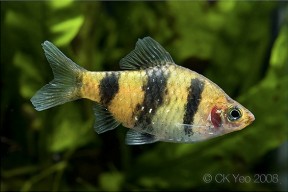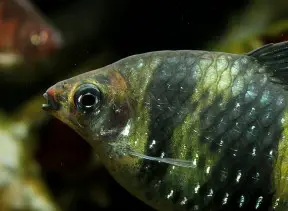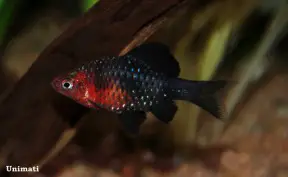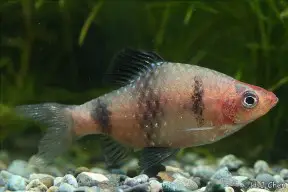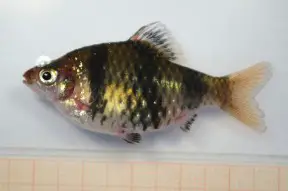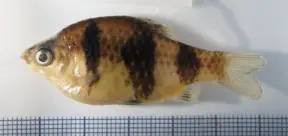Pethia nigrofasciata
Black Ruby Barb
SynonymsTop ↑
Barbus nigrofasciatus Günther, 1868; Puntius nigrofasciatus (Günther, 1868)
Etymology
Pethia: the generic vernacular name for small cyprinids in the Sinhala language.
nigrofasciata: from the Latin niger, meaning ‘black’, and fasciatus, meaning ‘banded’, in reference to this species’ colour pattern.
Classification
Order: Cypriniformes Family: Cyprinidae
Distribution
Endemic to Sri Lanka where it’s restricted to the Kelani and Nilwala river basins in the southwestern ‘wet zone’ of the island, plus smaller drainages in the area between them.
Export of wild specimens from Sri Lanka is currently prohibited meaning all those available in the aquarium trade should theoretically be bred on a commercial basis, although wild fish are apparently still collected.
Reports suggest that the more brightly-coloured fish are becoming scarcer and there exists a possibility that selective collection for the aquarium trade have altered the structure of wild populations.
That said, very little of the country’s forest cover remains due to human activities, with the result that habitat and water quality have been heavily degraded and numerous native fish species are now considered at risk of extinction.
Habitat
The ‘wet zone’ of southwestern Sri Lanka is an area receiving annual rainfall of 2000-3000 mm, much of which arrives during the South-West monsoons between March and August.
It’s a tropical environment with no significant dry spells or climatic changes, and air temperature is fairly constant throughout the year, ranging from 25 – 27 °C.
Such conditions favour development of lowland tropical rainforest at altitudes below 1000 m AMSL.
In Sri Lanka these forests are found only in the wet zone and they’re inhabited by a significant proportion of the country’s endemic flora and fauna with the moist, warm climate and long period of geographic isolation leading to exceptional localised biodiversity.
The vast majority has been cleared for plantation agriculture, however, much of it when the country was under British colonial rule, though a significant portion was also removed during the more-recent civil war, with more than 35% of the original cover lost between 1990 and 2005.
As of 2006 only 4.6% of the old forest was left with the remainder existing only in small, highly-fragmented patches, most covering areas less than 10 km², of which some are now officially-protected reserves.
Kottawa Forest is one of these and comprises just 15-20 hectares of wet, evergreen jungle, though the combined Kottawa-Kombala forest covers around 1600 ha.
A number of minor, pristine streams containing clear or slightly-stained, shallow water traverse the reserve and these represent typical habitats of P. nigrofasciata across its range.
Little sun is able to penetrate the forest floor so aquatic habitats are shaded and water temperature may be relatively cool, while conductivity and hardness are generally low and pH slightly acid.
Macrophytes are uncommon though there may be dense, marginal vegetation, sometimes overhanging the full width of the stream, the roots of which may penetrate the banks underwater.
Typical substrates are sandy but covered by a layer of leaf litter with fallen twigs and branches.
Sympatric fish species include Rasboroides vaterifloris, Puntius bimaculatus, P. kelumi, P. titteya, Dawkinsia singhala, Schistura notostigma, Mystus vittatus, Aplocheilus werneri, Channa orientalis, Malpulutta kretseri, and Mastacembelus armatus.
Maximum Standard Length
50 – 55 mm.
Aquarium SizeTop ↑
Base dimensions of at least 80 ∗ 30 cm or equivalent are required.
Maintenance
Choice of décor is not especially critical though it tends to show better colouration in a heavily-planted set-up with a dark substrate.
The addition of some floating plants, driftwood roots or branches, and leaf litter also seems to be appreciated and adds a more natural feel.
Filtration does not need to be particularly strong though it does seem to appreciate a degree of water movement and will also do well in a hill stream-type set-up.
Water Conditions
Temperature: 20 – 27 °C
pH: The farm-raised fish available in stores are fairly adaptable where water chemistry is concerned and should be happy within the range 5.5 – 7.5. Wild stock are likely to prefer slighty acidic to neutral conditions.
Hardness: 36 – 268 ppm. Wild fish will probably do best towards the lower end of this range.
Diet
Wild fish are probably foragers feeding on diatoms, algae, organic detritus, small insects, worms, crustaceans, and other zooplankton.
In the aquarium it’s easily-fed but the best condition and colours offer regular meals of small live and frozen foods such as bloodworm, Daphnia, and Artemia, alongside good quality dried flakes and granules, at least some of which should include additional plant or algal content.
Behaviour and CompatibilityTop ↑
Generally very peaceful making it an ideal resident of the well-researched community aquarium.
As it places no special demands in terms of water chemistry it can be combined with many of the most popular fish in the hobby including other small cyprinids as well as tetras, livebearers, rainbowfish, anabantoids, catfishes, and loaches.
It’s a schooling species by nature, and at least 6-10 specimens should be purchased.
Maintaining it in such numbers will not only make the fish less skittish but result in a more effective, natural looking display, plus males will develop better colours in the presence of conspecific rivals.
Sexual Dimorphism
Adult males are noticeably smaller, slimmer, and more colourful than females, especially during the spawning season when the overall colour pattern darkens with the head and anterior portion of the body becoming reddish-purple.
Reproduction
Like most small cyprinids Pethia spp. are egg-scattering free spawners exhibiting no parental care.
When in good condition they will spawn often and in a mature aquarium it’s possible that small numbers of fry may start to appear without intervention.
However if you want to maximise yield a more controlled approach is required.
The adult group can still be conditioned together but a smaller aquarium should also be set up and filled with mature water.
This should be very dimly lit and the base covered with some kind of mesh of a large enough grade so that the eggs can fall through but small enough so that the adults cannot reach them. The widely available plastic ‘grass’-type matting can also be used and works well, as does a layer of glass marbles.
Alternatively filling much of the tank with a fine-leaved plant such as Taxiphyllum spp. or spawning mops can also return decent results.
The water itself should be of slightly acidic to neutral pH with a temperature towards the upper end of the range suggested above, and an air-powered sponge filter or air stone(s) should also be included to provide oxygenation and water movement.
When the adults are well-conditioned and the females appear gravid one or two pairs should then be introduced, and spawning should take place the following morning.
An alternative is to spawn the fish in a group with half a dozen specimens of each sex being a good number, although a larger aquarium may be necessary.
In either situation the adults will probably eat the eggs given the chance and should be removed as soon as any are noticed.
These should hatch in 24 – 48 hours with the fry free swimming around 24 hours later.
They should be fed on an infusoria-grade food for the first few days until large enough to accept microworm, Artemia nauplii, or suchlike.
NotesTop ↑
This species is sometimes traded as ‘purple-headed barb’ or simply ‘ruby barb’.
It was formerly included in the Puntius conchonius ‘group’ of closely-related species alongside P. ater, P. bandula, P. conchonius, P. cumingii, P. didi, P. erythromycter, P. gelius, P. khugae, P. macrogramma, P. manipurensis, P. meingangbii, P. nankyweensis, P. nigripinnis, P. padamya, P. phutunio, P. punctatus, P. reval, P. shalynius, P. stoliczkanus, P. thelys, P. tiantian, and P. ticto, but all of these were moved to the new genus Pethia by Pethiyagoda et al. (2012), as were P. melanomaculata, P. pookodensis, P. muvattupuzhaensis, P. ornatus, and P. yuensis.
‘Puntius‘ narayani was not moved to the new genus and is currently of uncertain generic placement since it uniquely possesses 9 branched dorsal-fin rays and 6 branched anal-fin rays.
Pethia species are defined by the following combination of characters: rostral barbels absent; maxillary barbels minute or absent; possession of a stiff, serrated last unbranched dorsal-fin ray; presence of a black blotch on the caudal peduncle, and frequently, black blotches, spots or bars on the side of the body; infraorbital 3 deep and partially overlapping the preoperculum.
P. nigrofasciata is one of several group members to possess a colour pattern consisting of three dark, vertically-orientated flank markings but can be told apart from congeners by the unique colour pattern of nuptial males.
There may be additional diagnostic characters but we’ve yet to obtain the relevant information.
The genus Puntius was viewed as a polyphyletic catch-all containing over 100 species of small to mid-sized cyprinid for a number of years until Pethiyagoda et al. (2012) published a partial review covering South Asian members.
The majority of sub-Himalayan Puntius species were reclassified and new genera Dawkinsia, Dravidia, and Pethia erected to accomodate some of them, with the remainder either retained in Puntius or moved to the existing Systomus assemblage, though the definition of the latter was altered meaning some Southeast Asian species formerly placed there are no longer members.
It subsequently became clear that the name Dravidia was preoccupied by a genus of flesh fly, therefore the replacement name Haludaria was made available by Pethiyagoda (2013).
No species from Indochina, China, or Indonesia were included in the study meaning a significant number of former Puntius are currently classed as incertae sedis, i.e., of uncertain taxonomic placement, and this also applies to a number of South Asian species of unresolved status.
They’re perhaps best referred to as ‘Puntius‘ for the time being whereby the genus name is surrounded by quotation marks to denote its questionable usage, and that is the convention used here on SF at the moment.
References
- Günther, A., 1868 - Catalogue of the fishes in the British Museum v. 7: i-xx + 1-512
Catalogue of the fishes in the British Museum. Catalogue of the Physostomi, containing the families Heteropygii, Cyprinidae, Gonorhynchidae, Hyodontidae, Osteoglossidae, Clupeidae,... [thru]... Halosauridae, in the collection of the British Museum. - Kottelat, M. and H-H Tan, 2011 - Ichthyological Exploration of Freshwaters 22(3): 209-214
Systomus xouthos, a new cyprinid fish from Borneo, and revalidation of Puntius pulcher (Teleostei: Cyprinidae). - Kullander, S. O. and F. Fang, 2005 - Copeia 2005(2): 290-302
Two new species of Puntius from northern Myanmar (Teleostei: Cyprinidae). - Kullander, S. O. and R. Britz, 2008 - Electronic Journal of Ichthyology, Bulletin of the European Ichthyology Society 2: 56-66
Puntius padamya, a new species of cyprinid fish from Myanmar (Teleostei: Cyprinidae). - Pethiyagoda, R., 2013 - Zootaxa 3646(2): 199
Haludaria, a replacement generic name for Dravidia (Teleostei: Cyprinidae). - Pethiyagoda, R., M. Meegaskumbura, and K. Maduwage, 2012 - Ichthyological Exploration of Freshwaters 23(1): 69-95
A synopsis of the South Asian fishes referred to Puntius (Pisces: Cyprinidae).

